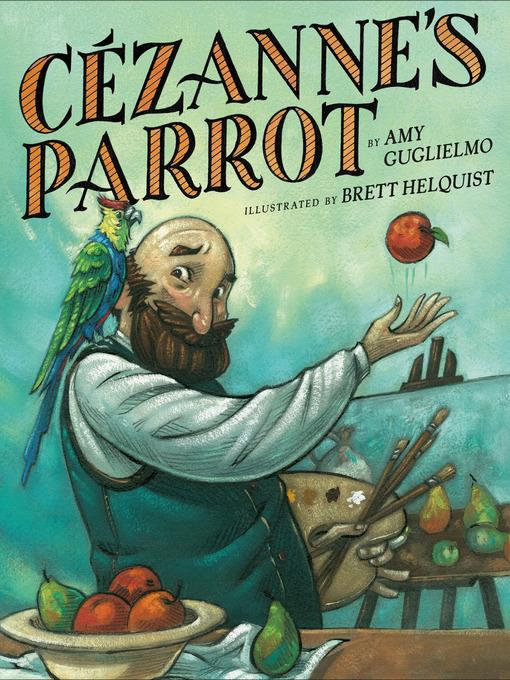
Cezanne's Parrot
فرمت کتاب
ebook
تاریخ انتشار
2020
Lexile Score
800
Reading Level
3-4
نویسنده
Jeremy Arthurشابک
9780525515098
کتاب های مرتبط
- اطلاعات
- نقد و بررسی
- دیدگاه کاربران
نقد و بررسی

November 15, 2019
Guglielmo seizes on Bisou, Paul Cézanne's pet parrot, as an entree into the life and work of the artist whom Pablo Picasso acclaimed as the father of 20th-century painting. Paul Cézanne was a nearly stereotypical struggling artist who abandoned his middle-class roots in Aix-en-Provence to carve out an art career in late-19th-century Paris. Neurotic, more than a bit depressed, and misanthropic, Cézanne was the odd man out among the impressionists. He was stolid and solid; they flew near the sun. Discouraged by his lack of conventional success, he found a sassy studio companion. Bisou was a clever mix of pet and service animal whom he trained to squawk an affirmation: "Cézanne is a great painter!" It worked. Cézanne worked. He became obsessively devoted to modeled tabletop still lifes, portraits, and figures (The Bathers, The Card Players, etc.). He finally exhibited and...he sold. Guglielmo does a good job focusing on the value of artistic persistence, but she relies only on Bisou for a hook, not taking the opportunity to incorporate the very kid-friendly character of Cézanne's son, Paul (the subject of nine portraits and countless drawings). Helquist contributes oil-on-paper illustrations that approximate Cézanne's palette and still-life skills, though the figures sometime border on the cartoony. Characters all present white. Readers will find this portrait of an artist distinctive, useful, and appealing. (author's note, selected bibliography, source notes, list of paintings) (Picture book/biography. 4-8)
COPYRIGHT(2019) Kirkus Reviews, ALL RIGHTS RESERVED.

December 2, 2019
Cézanne, the late 19th-century French painter, has lofty ambitions, and he wants his new parrot Bisou to acknowledge them: “Can you say, ‘Cézanne is a great painter’?” he instructs the bird. Cézanne rejects heroic subjects and traditional techniques. “While other artists painted flawless details with tiny brushes... Cézanne preferred thick paint and heavy marks.” He’s not a fast-working impressionist like his friend Monet, either. Cézanne paints agonizingly slowly, and sometimes he’s dissatisfied. At last, though, he gains recognition from the art world—and from his avian companion, too. Helquist (Guitar Genius) illustrates Cézanne’s story with boldly outlined and modeled figures in detailed period costume. His versions of Cézanne’s own paintings capture the painter’s lavish strokes and earthen tones. Spoken remarks—especially gossipy comments about Cézanne’s paintings (“Too dark!” “Too crude!”)—often appear in speech balloons. By examining the hard work and frustration that often lies behind what can look like inevitable celebrity, Guglielmo (How to Build a Hug) makes a solid case for understanding Cézanne as a painter who followed his own vision. An author’s note distinguishes between the historical record and fictional invention. Ages 4–8. Author’s agent: Stephen Barbara, InkWell Management. Illustrator’s agent: Steven Malk, Writers House.

March 13, 2020
PreS-Gr 3-In this picture book biography, struggling artist Cezanne and his parrot, Bisou, live together in the French countryside. Cezanne's work has been poorly received by art critics in Paris. He is surrounded by a circle of high-achieving artists, but gains no popularity when he bucks tradition by working more slowly than his peers, choosing common, everyday subjects to feature, and by painting with bold confidence instead of refined delicacy. Rather than imitate his predecessors, Cezanne wants to try something new. He seeks to bolster his self-esteem by asking Bisou to say "Cezanne is a great painter," but even the bird stubbornly refuses, displaying a humorous apathy towards all attempts to train him to speak. The artist's life changes overnight when he is invited to exhibit with a like-minded group of creatives and then returns to work with a rejuvenated spirit of determination. The resulting still lifes of fruit are so winsome that Bisou approves. Exquisitely painted illustrations are paired with the text; of particular note are an early spread of Cezanne working with Bisou in a meadow and an impressive series depicting the artist laboring in nine different attitudes. The illustration is everything one would want in a book about Cezanne: bold brushstrokes, heavy lines, and a color scheme that incorporates many of the browns, blues, and greens reminiscent of Cezanne's own artistic sensibilities. Helquist skillfully expresses Cezanne's changing feelings of worry, defeat, and eventual triumph by employing carefully crafted facial expressions and body postures to convey what the artist is thinking. Helquist's depiction of Bisou is equally expressive and animated, with great detailing in the feathers. VERDICT This brilliantly illustrated picture book shares a meaningful message about how to handle criticism, being true to yourself, and finding your crew. Recommended for nonfiction collections.-Lauren Younger, University of Dallas Library
Copyright 2020 School Library Journal, LLC Used with permission.

October 15, 2019
Grades 1-3 This fictionalized account of Paul C�zanne's life centers on his struggle for recognition, nicely illustrated by the initial refusal of his pet parrot to call him a great painter. C�zanne submits his work to institutions all over Paris, takes the advice of his painter friends to persevere, and tries a variety of subjects, but the parrot still won't acknowledge his talents. Finally, he lands on the subject for which he would eventually become famous?still life portraits of brightly colored fruit?and the parrot at last exclaims, "C�zanne is a great painter!" Helquist's dense paintings nicely evoke C�zanne's style, with impasto brushstrokes in bold colors, thick outlines of figures, and softly blended backgrounds, and the ever-present parrot injects a healthy dose of comedy. Though the plotline and some conversations are imagined, the artist really did have a parrot who said he was a great painter, and an author's note helpfully distinguishes fact from fiction, as well as offering more background on the post-impressionist's work and legacy. An inviting, playful introduction to an influential painter.(Reprinted with permission of Booklist, copyright 2019, American Library Association.)

























دیدگاه کاربران